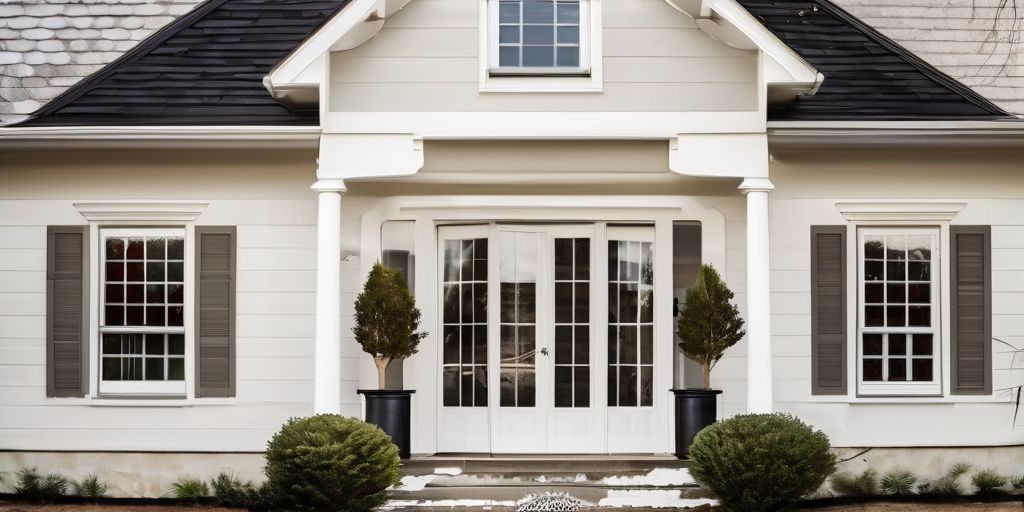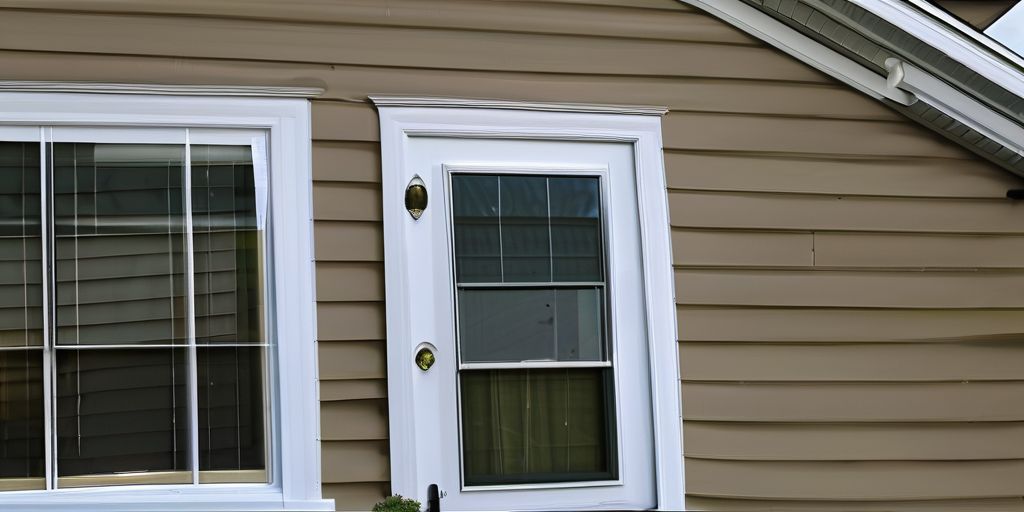Painting vinyl siding can significantly enhance the appearance of your home, but it requires thorough preparation to ensure a lasting finish. This guide will walk you through the essential steps to prepare your vinyl siding for painting, from cleaning and inspecting for damage to choosing the right paint and applying it under optimal weather conditions. Proper preparation is key to achieving a professional-looking result that will stand the test of time.
Key Takeaways
- Thoroughly clean the vinyl siding using a pressure washer or soapy water to remove dirt and grime.
- Inspect the siding for any damage, such as cracks or loose panels, and make necessary repairs before painting.
- Use painter’s tape and plastic sheeting to mask off areas like windows, doors, and trim to protect them from paint.
- Choose a high-quality, vinyl-safe paint and primer to ensure proper adhesion and durability.
- Paint under ideal weather conditions, avoiding extreme temperatures and monitoring the forecast for rain or high humidity.
Cleaning Your Vinyl Siding
Cleaning your vinyl siding is a crucial first step in preparing it for painting. Proper preparation ensures that the paint adheres well and lasts longer. Here are the essential steps to get your siding clean and ready for a fresh coat of paint.
Using a Pressure Washer
Using a pressure washer can be an effective way to clean your vinyl siding. However, it’s important to do it properly to avoid damage. Follow these steps:
- Choose the Right Nozzle: Use a nozzle with a wide spray pattern to prevent damage.
- Maintain Distance: Keep the nozzle at least 2 feet away from the siding.
- Work from the Top Down: This helps to avoid streaks and ensures thorough cleaning.
Scrubbing with Soapy Water
If you prefer a more hands-on approach, scrubbing with soapy water is a great alternative. Here’s how to do it:
- Create a Cleaning Solution: Mix powdered laundry detergent, household cleaner, and a bit of bleach in water to tackle dirt, mildew, and any grime on your siding.
- Use a Soft Bristled Brush: Gently scrub the siding with the solution. A soft brush ensures you don’t damage the vinyl while removing all the unwanted buildup.
- Rinse Thoroughly: After scrubbing, rinse the siding with clean water from a garden hose, ensuring all cleaning solutions and loosened dirt are washed away.
Rinsing and Drying
After cleaning, it’s essential to rinse and dry the siding properly. This step ensures that no cleaning solution is left behind, which could affect the paint’s adhesion.
- Rinse Each Section: Use a garden hose to rinse each section immediately after scrubbing.
- Direct the Water Stream Downward: This prevents water from getting behind the siding.
- Allow to Dry Completely: Make sure the siding is completely dry before moving on to priming or painting.
Hand scrubbing is very effective and may be safer for the siding than pressure washing. If you choose to use a pressure washer, make sure to do it properly to avoid damage.
Inspecting for Damage
Before you start painting, it’s important to assess the condition of your vinyl siding. Inspect for any signs of damage, such as cracks, chips, or loose panels. If any repairs are needed, address them before proceeding with the painting process. Clean your siding thoroughly to remove any dirt, grime, or mildew that may have accumulated over time. A clean surface ensures better paint adhesion and a smoother finish.
Masking Off Areas
Before you start painting, it’s crucial to protect areas adjacent to the siding. Proper masking ensures a clean and professional finish. Here are the essential steps to follow:
Protecting Windows and Doors
- Use painter’s tape to mask off windows, doors, and trim. This will keep these areas free from paint.
- Apply masking paper or plastic sheeting to cover larger surfaces.
- Ensure the tape is firmly pressed down to prevent paint from seeping through.
Using Painter’s Tape Effectively
- Choose a high-quality painter’s tape that is suitable for outdoor use.
- Apply the tape in long, continuous strips to avoid gaps.
- Remove the tape slowly and at an angle to avoid peeling off any paint.
Covering Trim and Fixtures
- Use plastic sheeting or drop cloths to cover trim, fixtures, and any other surfaces you don’t want to paint.
- Secure the coverings with painter’s tape to keep them in place.
- Double-check that all areas are adequately covered before you start painting.
Due to its thinness, masking film sticks easily onto flat surfaces without needing tape. This makes it an excellent choice for covering large areas quickly and efficiently.
Choosing the Right Paint
Selecting the right paint for your vinyl siding is crucial to ensure a long-lasting and beautiful finish. Here are the essential steps to guide you through the process.
Selecting Vinyl-Safe Paint
When choosing paint for vinyl siding, it’s important to select a product specifically formulated for vinyl. Vinyl-safe paints are designed to adhere properly and expand and contract with the siding, preventing cracks and peeling. Look for paints labeled as suitable for vinyl to ensure the best results.
Understanding Paint Finishes
Paint finishes can significantly impact the appearance and durability of your paint job. Common finishes include:
- Flat/Matte: Offers a non-reflective finish, ideal for hiding imperfections.
- Satin: Provides a slight sheen and is more durable than flat finishes.
- Semi-Gloss: Offers a shiny finish and is highly durable, making it great for high-traffic areas.
- Gloss: The shiniest finish, offering maximum durability and easy cleaning.
Choose a finish that balances aesthetics and practicality for your home’s exterior.
Reading Product Labels
Before purchasing paint, take the time to read the product labels carefully. Look for information on:
- Coverage: How much area the paint will cover per gallon.
- Drying Time: The time required for the paint to dry between coats.
- Weather Resistance: The paint’s ability to withstand various weather conditions.
- Warranty: Any guarantees provided by the manufacturer.
Reading labels ensures you select a high-quality product that meets your needs.
Remember, the color you choose can significantly affect your home’s curb appeal and even its value. Whether you’re drawn to classic neutrals or bold, statement hues, make sure your selection complements your home’s overall style and fits within any neighborhood guidelines.
Applying Primer and Paint
Setting Up Your Supplies
Before you begin, gather all necessary supplies. This includes:
- Primer (if needed)
- Exterior paint
- Paint sprayer or roller
- Brushes for detail work
- Drop cloths
- Painter’s tape
Having everything ready will make the process smoother and more efficient.
Priming the Surface
Primer is recommended to ensure the finished paint job is consistent and has good adhesion. It may not be necessary if the original color hasn’t completely or partially worn away. If the vinyl is pitted or porous, it will also benefit from primer. Apply the primer using a paint sprayer, roller, or brush. Always back brush to ensure full coverage and remove drips.
Painting Techniques for Vinyl Siding
After the primer is dry, apply your chosen paint with a roller or a paint sprayer, saving brushwork for corners and edges. Evenly coat the entire surface, taking care not to apply too much paint in any one section. As for most other types of paint jobs, it’s better to do multiple light coats than one thick coat. Apply a second coat after the first one dries as directed by the paint manufacturer.
Proper preparation and technique are key to a successful paint job on vinyl siding. Take your time and follow each step carefully for the best results.
Weather Considerations
Ideal Painting Conditions
To achieve the best results, aim for a day with mild temperatures, ideally between 50°F and 85°F, and low humidity. Overcast skies are also beneficial as they prevent the paint from drying too quickly or unevenly. High humidity or extreme temperatures can affect the drying process and the overall finish.
Monitoring the Forecast
Always consult the weather forecast before starting your painting project. Ensure there’s no rain expected on the day of painting and at least 24 hours afterward to allow the paint to dry completely. This step is crucial because if the weather becomes unfavourable, such as extremely windy, sunny, or hot, the vinyl painting will be interfered with.
Avoiding Extreme Temperatures
Extreme temperatures, whether too hot or too cold, can negatively impact your painting project. Aim to apply spray paint when the ambient temperature falls between 40 to 80 degrees Fahrenheit and the humidity level reaches between 40 to 50 percent. This ensures that the paint adheres properly and dries evenly.
Final Touches and Clean-Up
Removing Tape and Coverings
Once the paint has dried, it’s time to remove all masking materials. Carefully peel off the painter’s tape and coverings from windows, doors, and trim. This will help you see the final result and identify any areas that need touch-ups.
Inspecting the Paint Job
After removing the tape and coverings, inspect the entire paint job. Look for any missed spots, drips, or uneven areas. Touch up any imperfections with a small paintbrush to ensure a flawless finish. This step is crucial for a professional and durable exterior paint finish.
Cleaning Your Tools
Properly cleaning your tools will extend their lifespan and keep them in good condition for future projects. Follow these steps:
- Rinse brushes and rollers with water (for latex paint) or the appropriate solvent (for oil-based paint).
- Use a brush comb or wire brush to remove any remaining paint.
- Let the tools dry completely before storing them.
Taking the time to clean up thoroughly will make your next painting project much easier and more enjoyable.
As you wrap up your home improvement project, don’t forget the final touches and clean-up to ensure everything looks perfect. For more tips and professional services, visit our website and explore how we can help you achieve a flawless finish.
Conclusion
Painting your vinyl siding can be a rewarding project that enhances the curb appeal and longevity of your home. By following the essential steps outlined in this guide, from thorough cleaning and surface preparation to choosing the right paint and applying it correctly, you can achieve professional-looking results. Remember, patience and attention to detail are key. Take your time to ensure each step is done properly, and you’ll be able to enjoy the fresh, updated look of your home for years to come. Happy painting!
Frequently Asked Questions
What is the best way to clean vinyl siding before painting?
The best way to clean vinyl siding is by using a pressure washer or scrubbing it with a mixture of water and mild detergent. Rinse thoroughly and allow the siding to dry completely.
Can I paint over damaged vinyl siding?
It’s important to inspect your vinyl siding for any damage, such as cracks, chips, or loose panels, and repair them before painting. Sand any rough spots to create a smooth surface.
How do I protect areas I don’t want to paint?
Use painter’s tape and plastic sheeting to mask off windows, doors, trim, and other areas you don’t want to paint. This will protect these surfaces from paint splatters.
What type of paint should I use for vinyl siding?
Select a vinyl-safe paint that is specifically formulated for use on vinyl siding. It’s also important to understand paint finishes and read product labels to ensure proper adhesion and durability.
When is the best time to paint vinyl siding?
The best time to paint vinyl siding is during ideal weather conditions, typically when the temperature is moderate and there is no rain in the forecast. Avoid painting in extreme temperatures.
Do I need to apply a primer before painting vinyl siding?
Applying a high-quality primer formulated for vinyl surfaces is recommended to ensure better adhesion and longevity of the paint job. Make sure the surface is clean and dry before priming.







